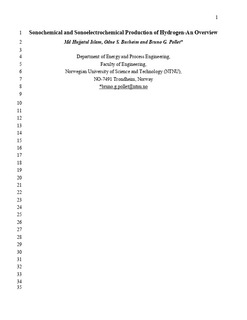| dc.contributor.author | Islam, Md Hujjatul | |
| dc.contributor.author | Burheim, Odne Stokke | |
| dc.contributor.author | Pollet, Bruno | |
| dc.date.accessioned | 2019-04-30T11:50:35Z | |
| dc.date.available | 2019-04-30T11:50:35Z | |
| dc.date.created | 2018-10-08T00:56:29Z | |
| dc.date.issued | 2018 | |
| dc.identifier.citation | Ultrasonics sonochemistry. 2019, 51 533-555. | nb_NO |
| dc.identifier.issn | 1350-4177 | |
| dc.identifier.uri | http://hdl.handle.net/11250/2596150 | |
| dc.description.abstract | Reserves of fossil fuels such as coal, oil and natural gas on earth are finite. The continuous use and burning of these fossil fuel resources in the industrial, domestic and transport sectors has resulted in the extremely high emission of greenhouse gases, GHGs (e.g. CO2) and solid particulates into the atmosphere. Therefore, it is necessary to explore pollution free and more efficient energy sources in order to replace depleting fossil fuels. The use of hydrogen (H2) as an alternative fuel source is particularly attractive due to its very high specific energy compared to other conventional fuels and its zero GHG emission when used in a fuel cell. Hydrogen can be produced through various process technologies such as thermal, electrolytic, photolytic and biological processes. Thermal processes include gas reforming, renewable liquid and biooil processing, biomass and coal gasification; however, these processes release a huge amount of greenhouse gases. Production of electrolytic hydrogen from water is an attractive method to produce clean hydrogen. It could even be a more promising technology when combining water electrolysis with power ultrasound to produce hydrogen efficiently where sonication enhances the electrolytic process in several ways such as enhanced mass transfer, removal of hydrogen and oxygen (O2) gas bubbles and activation of the electrode surface. In this review, production of hydrogen through sonochemical and sonoelectrochemical methods along with a brief description of current hydrogen production methods and power ultrasound are discussed. | nb_NO |
| dc.language.iso | eng | nb_NO |
| dc.publisher | Elsevier | nb_NO |
| dc.rights | Attribution-NonCommercial-NoDerivatives 4.0 Internasjonal | * |
| dc.rights.uri | http://creativecommons.org/licenses/by-nc-nd/4.0/deed.no | * |
| dc.title | Sonochemical and Sonoelectrochemical Production of Hydrogen - A Review | nb_NO |
| dc.type | Journal article | nb_NO |
| dc.type | Peer reviewed | nb_NO |
| dc.description.version | acceptedVersion | nb_NO |
| dc.source.pagenumber | 533-555 | nb_NO |
| dc.source.volume | 51 | nb_NO |
| dc.source.journal | Ultrasonics sonochemistry | nb_NO |
| dc.identifier.doi | 10.1016/j.ultsonch.2018.08.024 | |
| dc.identifier.cristin | 1618538 | |
| dc.description.localcode | © 2018. This is the authors’ accepted and refereed manuscript to the article. Locked until 22.09.2020 due to copyright restrictions. This manuscript version is made available under the CC-BY-NC-ND 4.0 license http://creativecommons.org/licenses/by-nc-nd/4.0/ | nb_NO |
| cristin.unitcode | 194,64,25,0 | |
| cristin.unitname | Institutt for energi- og prosessteknikk | |
| cristin.ispublished | true | |
| cristin.fulltext | original | |
| cristin.fulltext | postprint | |
| cristin.qualitycode | 1 | |

